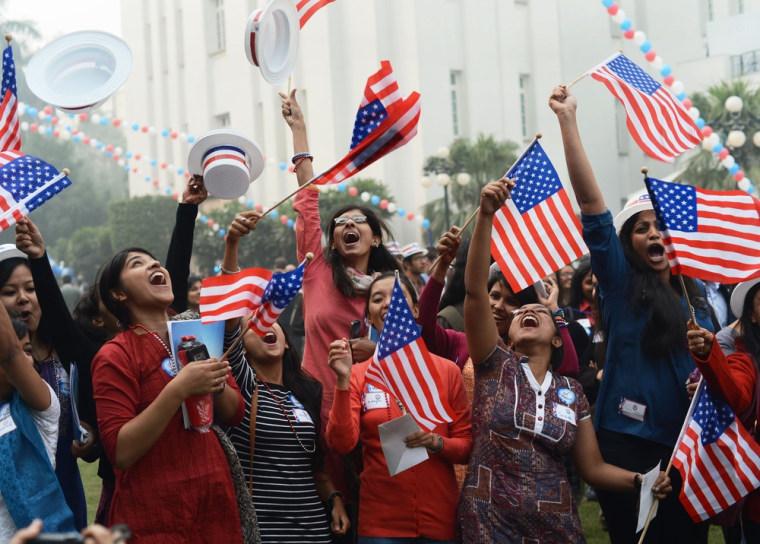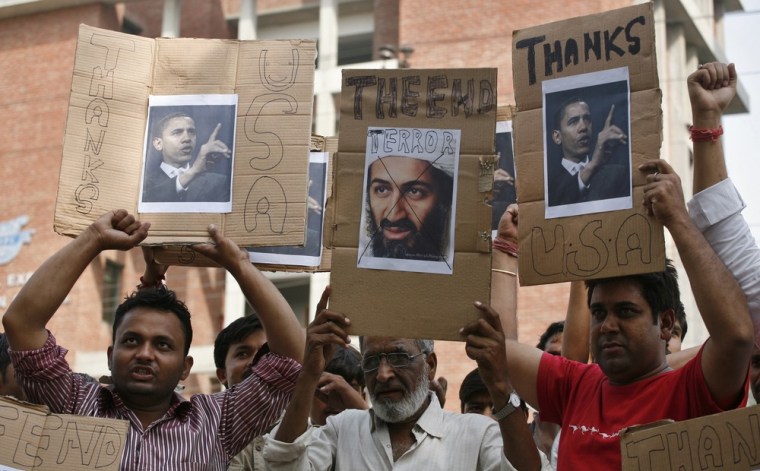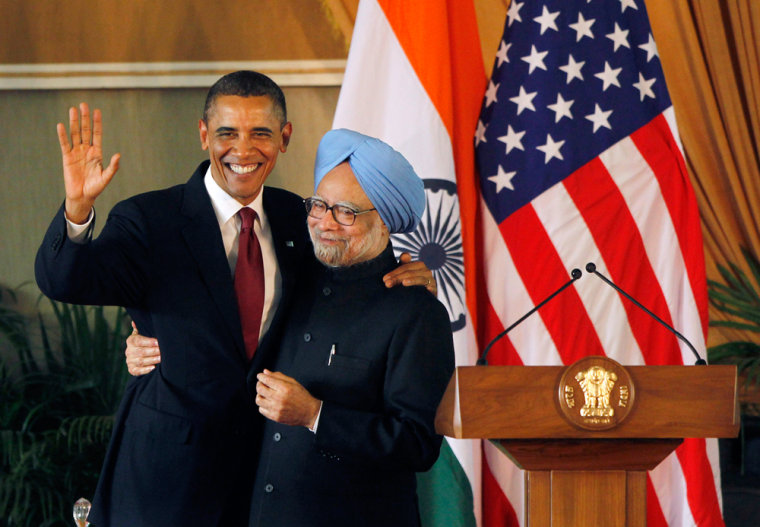Joe Biden arrives there on Monday, John Kerry declared it his “second home” on his trip last month, and Barack Obama will host its leader in the fall: But why is India the subject of such a concerted American charm offensive?
The answer essentially boils down to money, military hardware and a shared love of freedom — to paraphrase the opinions of a number of experts.
Some believe the world’s two biggest democracies will ultimately “shape the destiny of the 21st century.”
A senior Obama administration official said Friday that Biden would meet with Indian Prime Minister Manmohan Singh and other leading officials in New Delhi on Tuesday and then head to Mumbai on Wednesday to give a speech at the Bombay Stock Exchange and meet with business leaders.
However, there are a number of signs suggesting the relationship might be in trouble -- a situation Washington appears keen to resolve.
Here are five reasons why India is feeling the love from the United States:
1. A bastion of democracy
Obama said the relationship between India and the U.S. would be one of the “defining partnerships” of the 21st century while visiting the country in 2010, praising its tradition of tolerance and its free market economy.
Ron Somers, president of the U.S.-India Business Council, went further.
“It’s going to be these two democracies that shape the destiny of the 21st century,” he said. “These are beacons of freedom and democracy on opposite sides of the planet and we’ve got to stick together with our close friends and believe in these principles.”
It was a partnership based on “democracy” and “a love, demand and insistence on freedom,” Somers added, while stressing these were not reasons to not trade with China.
Jody Venkatesan, national political director for the Republican Indian Committee in the U.S., said India’s importance had been recognized by George W. Bush during his time in office.
“The Bush administration made great overtures to the Indian-American community and toward India in general,” he said. “I think India has a strategic importance in terms of economic and intelligence purposes and freedom around the world.”

He said he felt relations between ordinary Indian and American people were also in a good place. “The Indian-American community has never betrayed the trust of the American public — and that’s huge,” he said.
But some in India believe American commitment to democratic values is not quite as strong as it should be.
Brahma Chellaney, a former adviser to India’s National Security Council, said India was concerned that the U.S. used its promotion of democracy as a political tool in some parts of the world “while staying quiet on China.”
“The Americans don’t speak about Tibet at all and don’t speak much about human rights” in China, he said by phone from New Delhi.
2. Booming economy
India’s economy has been growing at rates that rival the boom in China.
According to the World Bank, India’s gross domestic product rose from $1.2 trillion in 2008 to more than $1.8 trillion in 2012 – a rise of 50 percent during a time when much of the world was going through the worst economic hardship for decades.
“Europe, unfortunately, is flat on its back economically and China is also having challenges with their economy,” said Somers, of the U.S.-India Business Council. “The United States and India need to be developing a greater economic partnership now more than ever.”
The amount of two-way trade between India and the United States has quadrupled in just seven years -- from $25 billion in 2006 to about $100 billion in 2013, he said.
A senior Obama administration official said there was “no reason” that the current level of trade between the two countries could not be “five times as much.” Biden plans to raise issues about U.S. investment during his visit.
Ten years ago, defense trade between the two countries was worth just $100 million. Somers said this had since risen to $10 billion and stressed India had billions more to spend on defense, particularly as it seeks to expand its navy.
“In the recent floods in Uttarakhand, those were [U.S.-made] C-17 and C-130J aircraft that were helping bring in medical supplies and helping rescue people,” he said.
The Indo-U.S. nuclear agreement of 2008 saw the United States agree "to enable full civil nuclear energy cooperation" with India, effectively ending India's isolation as a nuclear state following its nuclear bomb test in 1974.
Achin Vanaik, a professor at the political science department of Delhi University, said the deal was hugely important to India, but suggested its government's later decision to spend about $20 billion on French fighter jets, rather than American ones, was a disappointment to Washington.
"The Americans thought after the U.S. nuclear deal the Indians would buy their fighter planes, but it ended up with the Indians buying from the French -- that's a huge thing," he said. "It obviously annoyed the Americans to some extent. They expected certain pay-offs."
Somers, who was closely involved in the nuclear deal, strongly denied any suggestion of a "quid pro quo" on arms sales.
However, he admitted there were other tensions, saying U.S. businesses had concerns about enforcement of intellectual property rights in India and also about regional differences about how taxes are applied.
And U.S. Trade Representative Michael Froman has also expressed concern about efforts to stimulate the economy by forcing Indian companies to buy home-produced goods.
3. A key ally in the war on terror
India has become a close ally of the United States in the fight against Islamist militants after suffering its own terrorist attacks.
Three months after the Sept. 11, 2001, attacks on the United States, India’s parliament in New Delhi was stormed by five men armed with guns, grenades and other explosives. Ten people died before the attackers were killed.
And in 2008, 166 people were killed when gunmen attacked a Jewish center and two five-star hotels in Mumbai. India has blamed the attack on Pakistan-based militants.
But recently the relationship has hit a rocky patch over the prospect of a U.S. peace deal with the Taliban in Afghanistan, something India fears would give its arch-rival Pakistan greater power in the region.
Chellaney, the former adviser to India’s National Security Council who now professor of strategic studies at the Centre for Policy Research in New Delhi, said that India was “greatly troubled” by talk of a deal and believed the “political rehabilitation of the Taliban will be very injurious to regional security.”

“The Indians remain very concerned about the U.S. exit strategy, especially because these talks with the Taliban … are being conducted with the widespread support of the Pakistan army chief,” he said.
Any deal that saw the Taliban regain some political power would benefit India’s arch-rival Pakistan, giving them “a greater say in the future of Afghanistan,” Chellaney said.
India does not have troops in Afghanistan, though the idea they could replace Western forces after the 2014 pullout has been raised recently.
India has been a major supplier of aid to Afghanistan, spending a total of more than $750 million between 2002 and 2009. Afghan President Hamid Karzai met Indian Prime Minister Singh in May to discuss supplies of military equipment.
A senior Obama administration official said co-operation with India on “maritime security” and “counter terrorism” would be one of the issues at the top of the agenda. He spoke of a “strategic convergence” between India and the U.S.
Asked about Indian concern over talks with the Taliban, the official stressed the United States’ view that the militant movement would have “to be breaking with al Qaeda, renouncing violence and abiding by the terms of the Afghan constitution” to be part of an Afghan-led peace process.
4. A counterweight to China
India and the United States are the world’s two biggest democracies, but the world’s most populous country is China.
And is its economy has surged, it has begun to flex its muscles, pursuing territorial disputes with many of its neighbors.
India and China fought a war in 1962 and in April and May this year there was a three-week standoff after Chinese troops “intruded in Indian territory,” according to Indian officials.
Award-winning historian Margaret MacMillan — author of both “Nixon and Mao,” about the two leaders’ famous 1972 meeting, and “Women of the Raj,” about India during British rule — said she thought U.S.-Chinese relations had “proved to be disappointing for the Obama administration.”
The extended diplomatic push aimed at New Delhi might be a way of sending a message to Beijing, she said.
“It suggests to me the great Asian pivot with improved relations with China has turned out to be a bit of a bust,” said MacMillan, who is a professor at St. Anthony’s College, Oxford University.
However, she said the U.S. would probably try to avoid picking a side and stay in the middle.
“It’s a tricky game, but if you can be the power at the center and tilt to one side and the other, it actually gives you a lot of influence,” she said.
5. Biden might have some explaining to do
The somewhat gaffe-prone Biden declared in 2006 that “You cannot go to a 7-11 or a Dunkin Donuts unless you have a slight Indian accent ... I'm not joking.”
Biden’s staff later clarified he was praising the “vibrant” Indian-American community in Delaware, and making the point that along with engineers, scientists and physicians, there was a growing number of more middle-class people.
And then last year, he made headlines when he briefly appeared to imitate an Indian accent while talking about American job losses and overseas call centers last year.
Chellaney said Biden’s attempt at mimicry had been “front-page news” in India, but doubted it would cause any problems on his trip.
“The public memory in India is really short. Most people will have forgotten these incidents. I think he will be warmly received in India,” he said.
And Somers insisted Biden was “one of the best friends of India that has ever come from the United States,” noting his championing of the Indo-U.S. nuclear agreement.
And The Times of India was reasonably relaxed about Biden’s apparent mimicry, noting his “penchant for bloopers” and saying it was “mild” by his usual standards.
